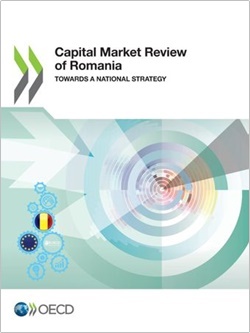Corporate governance
OECD Capital Market Review of Romania
|
Published on June 27, 2022 Read the full report
|
Launch of the Review
The new OECD Capital Market Review of Romania aims to support Romania in improving the framework and general functioning of its capital market and to guide the development of a national capital market strategy. The policy recommendations focus on conditions for stock market listing, secondary stock market liquidity, growth markets, modalities for household savings, institutional investors, and market based debt financing. The review was launched on 27 June by Romania’s State Secretary at the Ministry of Finance, Mihai Precup, Director General of the EC Directorate-General for Structural Reform Support, Mario Nava and OECD Director for Financial and Enterprise Affairs, Carmine Di Noia. Download agenda of the launch event
About the Review
In the years before the COVID-19 crisis, Romania enjoyed strong economic growth which led to an important rise in income per capita and a decline in unemployment. The crisis halted this progress and led to sharp declines in revenues, putting many companies under financial stress. The crisis also revealed a number of long-term structural challenges in the Romanian corporate sector and capital markets.
The OECD Capital Market Review of Romania argues that a well-functioning capital market that ensures access to different sources of financing will be essential to foster sustainable economic development in Romania and help advance Romania’s integration into the European financial system. The report reveals that the Romanian capital market is currently undersized. The country’s share in the European Union’s total stock market capitalisation is well below its share in the EU’s GDP. Since 2008, 45 companies have delisted from the regulated market, compared to only 16 new listings. No capital has been raised through initial public offerings since 2017, and up until 2020 secondary public offerings were non-existent.
The report highlights that the Romanian corporate sector is over-reliant on bank financing and a large share of firms remain credit-constrained. Even though 99% of Romanian companies’ debt financing is made up of bank loans, total bank loans to GDP represent only one-third of the EU average. Market-based financing, meanwhile, represents only one-eighth of average EU levels. Moreover, SMEs in Romania have low levels of capitalisation and a significant share are credit-constrained. In addition, despite having implemented a funded private pension system, the limited development of the domestic securities market is preventing pension funds from diversifying their portfolios towards a more effective balancing of risk and return.
The policy recommendations proposed in the report are intended to provide guidance to policy makers and authorities in their efforts to introduce a Romanian capital market strategy. This review has been funded by the European Union via the Structural Reform Support Programme and implemented by the OECD. View the Key FindingsSee also OECD Capital Market Review of Romania: Mapping Report (2021) More OECD work on capital markets
|
|
|
|
|
|
Related Documents

